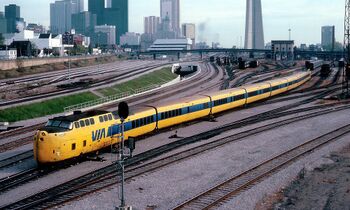SRC Nimbus
This article is incomplete because it is pending further input from participants, or it is a work-in-progress by one author. Please comment on this article's talk page to share your input, comments and questions. Note: To contribute to this article, you may need to seek help from the author(s) of this page. |
| SRC Nimbus | |
|---|---|
 Cacerta Royal Rail Line Nimbus in 1969. | |
| In service | 1961—1975 |
| Manufacturer | Sarissita Railway Company |
| Constructed | 1959—1962 |
| Entered service | 4 June 1961 |
| Number built | 63 vehicles (7 sets) |
| Formation | 9 cars per trainset |
| Capacity | 441 |
| Operator(s) | Cacertian Royal Rail Lines |
| Line(s) served | Vichenza-Cesena, Vichenza-Anzio |
| Specifications | |
| Car body construction | Aluminum |
| Train length | 165.91 m (544 ft 4 in) |
| Car length | Power Cars: 22.33 m (75 ft 3 in) Intermediate Cars: 17.32 m (56 ft 10 in) |
| Width | 3.18 m (10 ft 5 in) |
| Height | Coach: 3.33 m (10 ft 11 in) Dome: 3.94 m (12 ft 11 in) Exhausts: 4.22 m (13 ft 10 in) |
| Floor height | 0.79 m (2 ft 7 in) |
| Maximum speed | 193 km/h (120 mph) |
| Weight | 216 tonnes (212 long tons; 238 short tons) |
| Traction system | Direct drive through gearbox |
| Engine type | Gas turbine, turboshaft |
| Transmission | Mechanical |
| Electric system(s) | 600 V DC third rail |
| Current collection method | Contact shoe |
The SRC Nimbus was an early high-speed, gas turbine train that served as an initial proof-of-concept for the eventual high-speed rail network in Cacerta. The Nimbus operated on-and-off exclusively in the island of Sarissita from 1961 to 1975 before eventually being replaced by more advanced trains as technology improved.
Despite being historically significant as the first gas turbine-powered trains to enter passenger service in Siduri, they were historically plagued by technical and mechanical problems that prevented wider adoption throughout the country. By the time SRC had ironed out the Nimbus’ numerous issues, more reliable and efficient designs had begun entering service.
Of the seven train sets that were constructed, only one nine-car consist was preserved with the remaining six eventually sold for scrap.